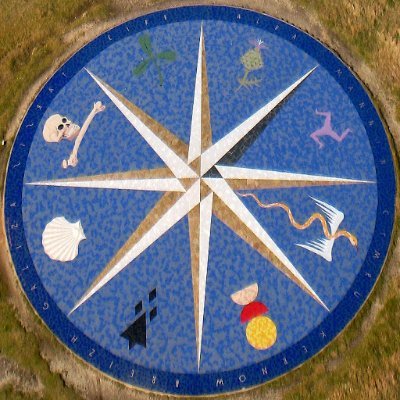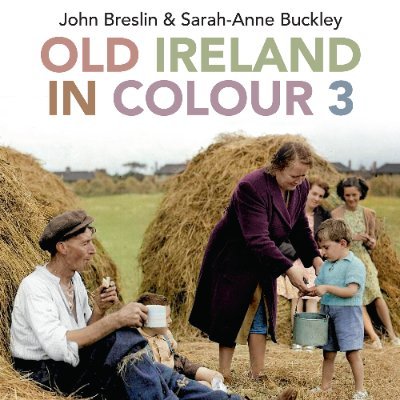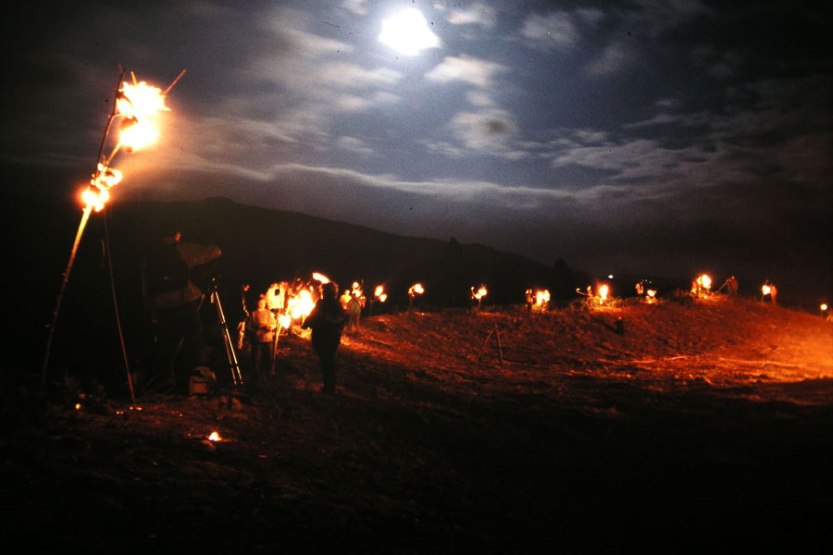
Beira Atlántica
@AtlanticaBeira
Followers
4K
Following
29K
Media
4K
Statuses
12K
Comunidade imaxinada. Caderno de bitácora dunha singradura de Fisterra a Cinn Tìre 🌅 #historia, #mitos, #música, #folklore... ▶️ Unrepentant Hibernophile.
Groyne/Cathair na Cruinne
Joined September 2020
#FindsFriday Granite head found in the hillfort of Santa Trega (A Guarda, #Galicia). This type of sculpture is often related to the Celtic cult of "severed heads". 📸 @GC_GCiencia
11
64
326
#FindsFriday. A triskelion engraved in granite, recently found in San Vicente hillfort (co. Avión, #Galicia). 📸 O Neto do Rei
5
62
300
Como me acaba de dicir unha seguidora, é de xustiza mostrar a foto completa: Sinéad con Carlos Núñez nos bastidores do Carnegie Hall, após un concerto con The Chieftains, naqueles felices e fulgurantes anos finais da década de 90. Porque. 👇
Pois fóisenos Sinéad O'Connor. Unha muller que vivía como cantaba: ardendo nos extremos. Que a terra lle sexa leve. E que soen as gaitas na súa viaxe a Tír na nÓg.
1
54
256
#FindsFriday . Baptismal font recently found by Eva Formoso in the chapel of Folgoso (#Galicia), with typical Gallaecian Iron Age decorative motifs (and even traces of polychromy). 📸 Paco Boluda (@PBoludaGROWIA)
5
75
259
#FaustianFriday . In #Galicia it is said that two or more crows walking together announce not only the death of someone, but also the number of priests who will officiate at the burial.
5
58
247
#FolkloreSunday .In #Ireland, yellow fresh flowers (usually gathered before dusk on May Eve, or before dawn on May Day) are left on doorsteps on May Day. Also in #Galicia and #Portugal, we put broom or gorse flowers (the "Maias") on the door on that day.
3
69
233
1/ The massive exodus of Irish Catholics to #Galicia in the first half of the 17th century remains remains little known to the general public. But we must not to fall into idealizations. Like any mass migration phenomenon, this one also brought tensions and conflicts.
5
70
235
Imos dar as boas vindas á semana cun tema no cal só agora reparei: o feixe de topónimos cuxa etimoloxía se relaciona na tradición mítica irlandesa con personaxes epónimos procedentes da Península Ibérica, e en concreto de #Galiza. Dá para un pequeno 🧵 e alá vou con el.
3
64
217
#HillfortsWednesday. Reconstruction of the clothing of a Gallaecian warrior statue found in the #Lesenho hillfort (co. Boticas, Northern #Portugal), by our very favorite artist Paco Boluda.
4
43
195
#WyrdWednesday . Stone heads, probably a manifestation of Celtic cult of severed heads, are abundant in Galician Iron Age art. It is not uncommon that they end up being reused in walls of houses, fountain pipes or other places. 📸 Stone heads from Armea hillfort (co. #Allariz).
0
52
186
#FolkloreThursday In Pedride (#Galicia) there is a stone cross under which an unbaptized child was buried. Since then, a huge black dog that nobody knows usually appears next to the cross (in Galician lore, the souls of the deceased usually appear in the form of black dogs).
3
46
178
#HillfortsWednesday "Castro" is the most common Galician word for "hillfort". In 17th C, Denis MacCrath, one of the many Irish exiles in Galicia, adapted his name as "Denis de Castro", MB because he was born near Caiseal (which can easily be translated into Galician as "castro").
3
39
174
#HillfortsWednesday. The cistern of the Elviña hillfort (#Galicia), full after the intense rains of recent days. 📸 Dolores González
0
28
174
#HillfortsWednesday.In Galicia we usually say that there is a hillfort in every hamlet, so we have about 5K hillforts scattered all along the country! This map, made from data compiled by researcher Xabier Moure, shows the number of documented hillforts in each municipality 🤯
3
51
182
#TombTuesday.Tomb of Fernam Peres de Andrade (a great Galician nobleman of the 14th century) depicting a wild boar hunt. The bear and the wild boar on which the tomb rests are the totemic animals of the House of Andrade 🐗 🐻
4
37
171
#FindsFriday. 📀 The torc from Foxados (#Galicia), with its exquisite Celtic knots, is a masterpiece of ancient Galician goldsmithing. ⚱️ It was discovered in 1932. It had been buried in a pot containing three other torcs, a bracelet and several coins.
4
44
177
#HillfortsWednesday .Stone carvings found in Santa Trega hillfort (co. A Guarda, #Galicia), with usual symbols in Galician Iron Age art.
7
44
169
#WyrdWednesday The XACIOS live in the pools of the Miño river, in #Galicia. Many years ago, a "xacia" married a human boy and she even had children with him. But, after an argument, she returned to the river. Since she had been baptized, the other "xacios" killed her inmediately.
2
23
158
@PedroInsua1 Es realmente indignante que se vulnere sistemáticamente vuestro derecho a la ignorancia.
1
11
161
Hai inúmeras razóns, mais Santalla de Bóveda, por si soa, abondaría para xustificar o hashtag #LugoPatrimonioMundial
4
45
155
#SuperstitionSat The "pagaíños" ('little pagans') live in Northern #Galicia mountains. They are small, unkempt, long-haired beings that dwell underground. They do not like to interact with humans, although they can be seen dancing (with great dexterity) on top of certain rocks.
4
35
152
#TombTuesday . A team led by the GIAP research group of the Institut Català d'Arqueologia Clàssica has published the first results of the application of AI to the location of archaeological sites. They have located about 9,000 megalythic mounds only in #Galicia! 👇
3
58
158
#FindsFriday. An inscribed stone from Roman times reused in a wall of the chapel of San Miguel das Uvas (co. Bande, #Galicia). It contains a fragment of the ethnonym QVERQVERNI ('the oak tree people'), the name of the Celtic people that inhabited that area. 📸 Dolores González
5
29
152
#HillfortsWednesday .Inspired by the statues of Gallaecian warriors and objects found in Galician and Portuguese #hillforts, artist Miguel Torre has recreated the appearance of a "corono" (chieftain) from Southern #Gallaecia during the Iron Age.
5
35
143
#FolkloreThursday .In #Galicia, at this time, it is common to carve pumpkins (and even turnips or melons) in the shape of a human head. In some towns, this pumpkin is dried and used as a mask in the #Entroido (Galician traditional carnival).
3
36
136
#SuperstitionSat In #Galicia, the "ánimas" are the souls of the deceased who are not in Heaven or Hell. They often interact with the living to help them or to ask them to deal with certain issues which they could not solve in life (e.g., going to pilgrimage to some shrine).
1
32
143
#FaustianFriday .Orcavella was a horrible, child-eating hag who ravaged the Kingdom of Galicia for 176 years. When she decided to die, she forced a young shepherd to build a tomb for her in the vicinity of Cape Fisterra. Then she buried him alive with her!
3
31
140
#EpigraphyTuesday . An inscribed stone from Roman times reused in a wall of the chapel of San Miguel das Uvas (co. Bande, #Galicia). It contains a fragment of the ethnonym QUERQUERNI ('the oak people'), the name of the Celtic people that inhabited that area. 📸 Dolores González
1
37
137
#FairyTaleTuesday .In Galician and Portuguese lore, the "peeira de lobos" is a woman (usually the seventh daughter of a marriage) who flees to the forest to live with a pack of wolves, which she leads as if she were their captain.
2
38
138
#SuperstitionSat White quartz stones are a common apotopraic element in old Galician houses, both embedded in the walls and placed on the top of roofs and chimneys.
4
27
132
#StandingStoneSunday The Pedra Alta, in the former Antela lake (#Galicia), is believed to have been brought by a "moura" on her head, while spinning with a distaff. The legend (like the menhir) was Christianized, and the "moura" was replaced by Saint Mary. 📸 Miro Cerredelo
3
22
129
#FaustianFriday Difficult to choose a character from the diverse, colorful and sometimes terrifying Galician masquerades. But my favorite might be the Oso de Salcedo, who comes down from the mountain together with his sinister servants to smudge the faces of the merry passers-by.
3
28
128
#WyrdWednesday In Galician lore, "As Tres Marías" (the Three Marys) appear next to the dying person's bed, as an omen of his/her imminent death.
0
15
122
#StandingStoneSunday.In 1929, Galician politician, artist and writer #Castelao (1886-1950) visited the stone crosses and calvaries of #Brittany to study their similarities with the Galician ones. Here is the author posing next to the #Lancerf cross (co. #Plourivo, Bro-Dreger).
2
27
123
@MarioMartosJaen Dónde ha quedado aquello de "qué ponte en tu DNI?" que tanto os gusta sacar a relucir?.
1
2
112
#WyrdWednesday During a walk in the forest, abbot Saint Ero (founder of Armenteira monastery, in #Galicia) sat at the foot of a tree and, listening to the song of a bird, fell asleep. Upon awakening, he returned to the monastery. No monk recognized him. 300 years had passed! ⏳⏳
5
30
118
#March8 .One of the first Galician women whose name we know: Apana (from the tribe of the Celtici Supertamarici), to whom this beautiful funerary stele was dedicated.
5
31
121
1/9 Nesta altura é costume que rule pola rede a famosa frase admonitoria que preside o cemiterio de #Trobo, aló na miña terra chairega de cruces neogóticas e magníficos cruceiros. E aínda que non o creades, vou aproveitar para castigarvos con outro pequeno fío etimolóxico 😅🧵
2
18
122
#WyrdWednesday Three "mouras" (magical ladies) live in a dolmen in Monterroso (#Galicia). They are said to hold the capstone with their heads as they nurse each child and churn each pot of butter. It is also said that they gave #gifts to the boys, like coins and pieces of cloth.
3
23
119
#WyrdWednesday In #Galicia we say that if the Candeloria (Candlemas) cries (rainy weather 🌧️) half winter has already passed, but if the Candeloria laughs (sunny weather ☀️), there is still half of winter to pass. Candlemas is the day when birds get married, too.
6
32
121
1/15 Todas e todos sabedes do conto de Ero de #Armenteira, que inspirou unha das máis fermosas (e famosas) Cantigas de Santa María de Afonso o Sabio. Mais, por se acaso, ímolo relembrar brevemente.
4
28
117
#MythologyMonday. 🎨 "Leyenda marina", by Galician artist Urbano Lugrís (1908-1973). 🐳 The painting depicts the famous episode of Saint Brendan and the whale, according to "Nauigatio Sancti Brendani".
1
27
116
#FairyTaleTuesday In a Galician folktale, a lady emerged from a lake seated on a throne and asked a young man three times to dig a certain amount of soil in the forest. On the third time, she finally accepted the young man, who got into the water with her and disappeared forever.
2
25
114
#FairyTaleTuesday In some tales by Galician writer Álvaro Cunqueiro, the souls of the deceased turn into ravens and they even retain some characteristics that they had whey they were human (for example, a lame human will be a lame raven).
3
31
110
#FaustianFriday .In Galician lore, the so called "paxaro da morte" ('bird of death') is an invisible bird whose wails near houses portend someone's imminent death. For that reason, he is also called "avelaiona" ('the bird that wails') or even "paxaro cadaleito" ('coffin bird').
2
25
111
#HillfortsWednesday . In #Galicia there are many place names ending in -obre. It comes from a variant of -briga, a Celtic lexeme meaning "hillfort, fortress, walled city". A good and well known example is O Grove (medieval Ogobre = 'the point hillfort').
1
26
114
Bailaches Carolina. 🎶🎶.
Ag damhsa, Oileáin Árann. Dancing on the Aran Islands. 1929. Movietone 2-919 © @UofSClibraries .@palettefm @ffmpeg
4
10
110
#FolkloreSunday .Galician "lavandeira" (washerwoman), like Scottish "bean nìghe", is a woman who appears at night washing bloodstained clothes in a stream. If she asks you to help to twist her laundry, you must do it just the opposite way to her, and she will disappear.
1
25
111
#FaustianFriday In Castrolandín (#Galicia), 52 sticks with pine cones attached to them are driven around the perimeter of an ancient Iron Age fort. At midnight, people light the pine cones with the fire of the St John's bonfires. and the hillfort is surrounded by a wall of 🔥🔥
0
27
101
#TombTuesday . The "Casota de Freáns" or "Arca dos Mouros", in Berdoias (co. Vimianzo, #Galicia). The sculptures on one of its slabs have been interpreted by some scholars as depicting the Big Dipper.
2
17
112
#HillfortsWednesday.In Galician folklore, hillforts are often associated with hidden treasures. Sometimes we are lucky to find them! .Triskelion engraved in bronze found in Castromaior hillfort (4th century BC).
1
29
107
#SuperstitionSat. In Galician folklore, the Can Negro is a huge black dog that appears at night on the roads. If you ever meet him, you must tell him "Deus te acompañe" ('God be with you'), and the Can Negro will explode engulfed in fire.
5
28
97
Sabías que na Escocia hai un camiño medieval de peregrinación cuxo símbolo é a vieira e que atravesa o país de oeste para leste, terminando na catedral de Santo André, onde conservan as reliquias do santo? (a falanxe non, claro, que esa témola nós en Santo André de #Teixido 😬).
4
27
106
#SuperstitionSat .In #Galicia, the "trubincos" are a kind of goblins that go down the chimney on Christmas Eve. You must offer them as a gift a pine cone smeared in tar; if you don't, they will mess up your house and do all kinds of mischief!
2
34
104
#FaustianFriday . In Galician lore, "as Tres Marías" (the Three Marys) appear next to the dying person's bed, as an omen of his/her imminent death.
1
26
99
#StandingStoneSunday . "Pedra da Póvoa" in Trás-os -Montes region (NE #Portugal, ancient #Gallaecia). The stone (maybe an omphalos one) has interesting parallels in other Atlantic territories, such as #Brittany. 🎨 Illustration by Paco Boluda (@PBoludaGROWIA)
1
19
105
#FairyTaleTuesday Seven sisters were born from the crack of a stone near Pena de Anamão, between #Galicia and #Portugal. They became saints and are venerated in different sanctuaries in the region. One of them, Our Lady of Anamão, stayed in the place where the stone is found.
1
22
103
#HillfortsWednesday. Recreation of an Iron Age sauna in a Gallaecian hillfort. Source: "Kallaikos. Unha viaxe á Galiza céltica" (Paco Boluda, 2018).
1
28
101
#FaustianFriday.If you come across the #Estantiga, #Estadea or #Compaña (that is to say, rhe procession of the souls of the dead in Galician lore), you are in trouble 🤦 Luckily, there are ways to get out of that situation. I tell you some of them🧵
1
22
96
#FaustianFriday A girl saw a "moura" (Otherworldly woman in Galician lore) combing her hair with a gold comb. She was taken by the "moura" to her underground palace and, after many years, she reappeared in her village, covered in rings and necklaces. And she hadn't aged at all!
1
26
99















































































































